check engine light Acura TL 2000 3.2 Owner's Manual
[x] Cancel search | Manufacturer: ACURA, Model Year: 2000, Model line: TL, Model: Acura TL 2000Pages: 311, PDF Size: 3.05 MB
Page 48 of 311
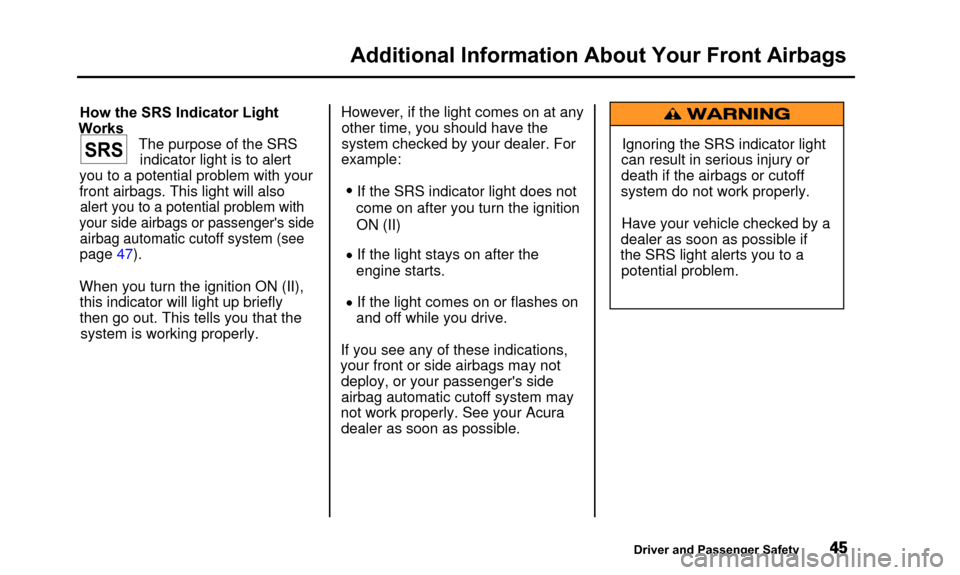
Additional Information About Your Front Airbags
How the SRS Indicator Light
Works The purpose of the SRSindicator light is to alert
you to a potential problem with your
front airbags. This light will also
alert you to a potential problem with
your side airbags or passenger's side airbag automatic cutoff system (see
page 47).
When you turn the ignition ON (II), this indicator will light up briefly
then go out. This tells you that the system is working properly. However, if the light comes on at any
other time, you should have the
system checked by your dealer. For
example:
• If the SRS indicator light does not
come on after you turn the ignitionON (II)
• If the light stays on after the engine starts.
• If the light comes on or flashes onand off while you drive.
If you see any of these indications,
your front or side airbags may not deploy, or your passenger's side
airbag automatic cutoff system may
not work properly. See your Acura dealer as soon as possible. Ignoring the SRS indicator light
can result in serious injury or
death if the airbags or cutoff
system do not work properly.
Have your vehicle checked by a
dealer as soon as possible if
the SRS light alerts you to a potential problem.
Driver and Passenger Safety
SRS
Page 58 of 311
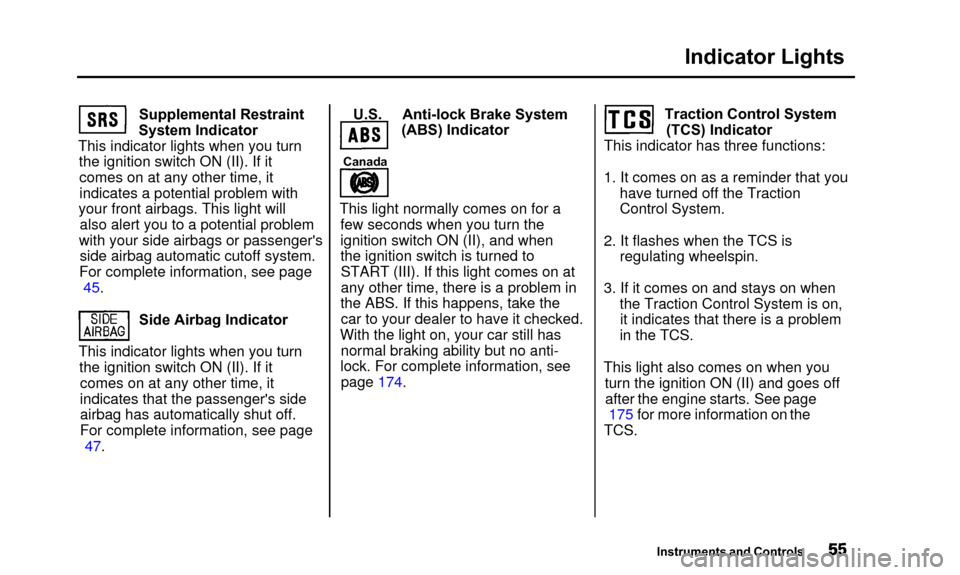
Indicator Lights
Supplemental Restraint
System Indicator
This indicator lights when you turn the ignition switch ON (II). If itcomes on at any other time, it
indicates a potential problem with
your front airbags. This light will also alert you to a potential problem
with your side airbags or passenger's side airbag automatic cutoff system.
For complete information, see page 45.
Side Airbag Indicator
This indicator lights when you turn the ignition switch ON (II). If itcomes on at any other time, it
indicates that the passenger's side
airbag has automatically shut off.
For complete information, see page 47. U.S. Anti-lock Brake System
(ABS) Indicator
Canada
This light normally comes on for a
few seconds when you turn the
ignition switch ON (II), and when
the ignition switch is turned toSTART (III). If this light comes on at
any other time, there is a problem in
the ABS. If this happens, take the car to your dealer to have it checked.
With the light on, your car still has normal braking ability but no anti-
lock. For complete information, see page 174. Traction Control System
(TCS) Indicator
This indicator has three functions:
1. It comes on as a reminder that you have turned off the TractionControl System.
2. It flashes when the TCS is regulating wheelspin.
3. If it comes on and stays on when the Traction Control System is on,it indicates that there is a problem
in the TCS.
This light also comes on when you turn the ignition ON (II) and goes offafter the engine starts. See page 175 for more information on the
TCS.
Instruments and Controls
Page 63 of 311
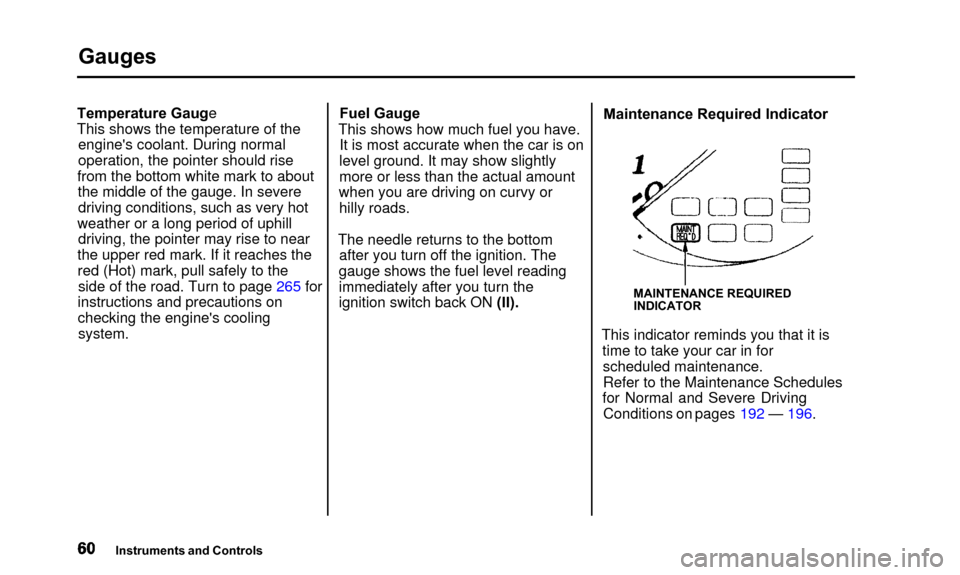
Gauges
Temperature Gauge
This shows the temperature of theengine's coolant. During normal
operation, the pointer should rise
from the bottom white mark to about the middle of the gauge. In severedriving conditions, such as very hot
weather or a long period of uphill driving, the pointer may rise to near
the upper red mark. If it reaches the red (Hot) mark, pull safely to theside of the road. Turn to page 265 for
instructions and precautions on
checking the engine's cooling system. Fuel Gauge
This shows how much fuel you have. It is most accurate when the car is on
level ground. It may show slightly
more or less than the actual amount
when you are driving on curvy or hilly roads.
The needle returns to the bottom after you turn off the ignition. The
gauge shows the fuel level reading
immediately after you turn the
ignition switch back ON (II). Maintenance Required Indicator
MAINTENANCE REQUIRED
INDICATOR
This indicator reminds you that it is
time to take your car in forscheduled maintenance.Refer to the Maintenance Schedules
for Normal and Severe Driving Conditions on pages 192 — 196.
Instruments and Controls
Page 163 of 311
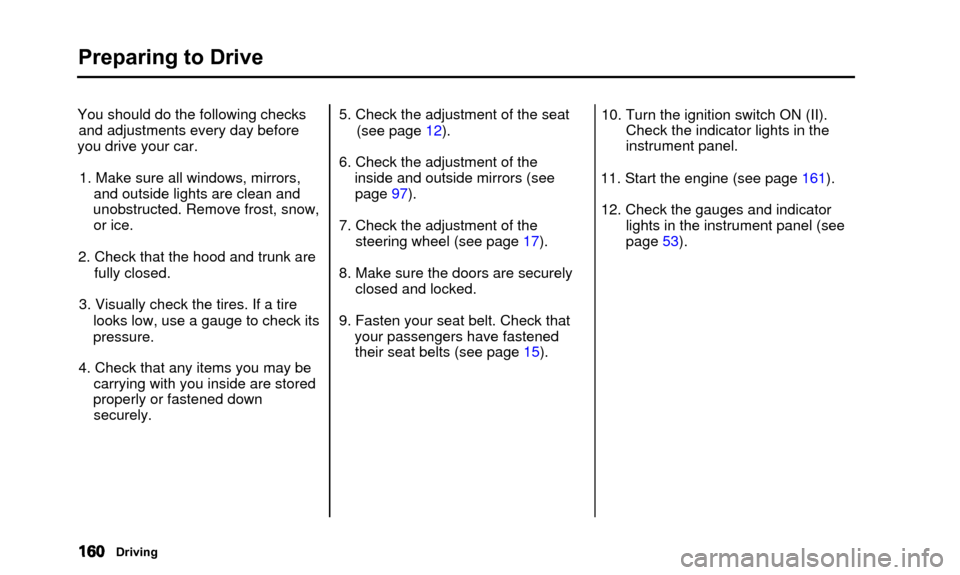
Preparing to Drive
You should do the following checksand adjustments every day before
you drive your car.
1. Make sure all windows, mirrors, and outside lights are clean and
unobstructed. Remove frost, snow, or ice.
2. Check that the hood and trunk are fully closed.
3. Visually check the tires. If a tire looks low, use a gauge to check its
pressure.
4. Check that any items you may be carrying with you inside are stored
properly or fastened down securely. 5. Check the adjustment of the seat
(see page 12).
6. Check the adjustment of the inside and outside mirrors (seepage 97).
7. Check the adjustment of the steering wheel (see page 17).
8. Make sure the doors are securely closed and locked.
9. Fasten your seat belt. Check that your passengers have fastenedtheir seat belts (see page 15). 10. Turn the ignition switch ON (II).
Check the indicator lights in the
instrument panel.
11. Start the engine (see page 161). 12. Check the gauges and indicator lights in the instrument panel (see
page 53).
Driving
Page 175 of 311

The Braking System
Your Acura is equipped with discbrakes at all four wheels. A powerassist helps reduce the effort needed
on the brake pedal. The ABS helps
you retain steering control when braking very hard.
Put your foot on the brake pedal only
when you intend to brake. Resting
your foot on the pedal keeps the brakes applied lightly, causing themto build up heat. Heat build-up can
reduce how well your brakes work. Italso keeps your brake lights on all
the time, confusing drivers behind
you. Constant application of the brakes
when going down a long hill builds up heat and reduces their effective-
ness. Use the engine to assist the
brakes by downshifting to a lower
gear and taking your foot off the accelerator pedal.
Check your brakes after driving
through deep water. Apply the
brakes moderately to see if they feel normal. If not, apply them gently and
frequently until they do. Since a longer distance is needed to stop
with wet brakes, be extra cautious and alert in your driving. Brake Wear Indicators
All four brakes have audible brake wear indicators.
When the brake pads need replacing,
you will hear a distinctive metallic "screeching" sound when you apply
the brakes. If you do not have the
brake pads replaced, they will begin screeching all the time.
Your brakes may sometimes squeal or squeak when you apply them
lightly. Do not confuse this with the
brake wear indicators. They make a
very audible "screeching."
Driving
Page 190 of 311
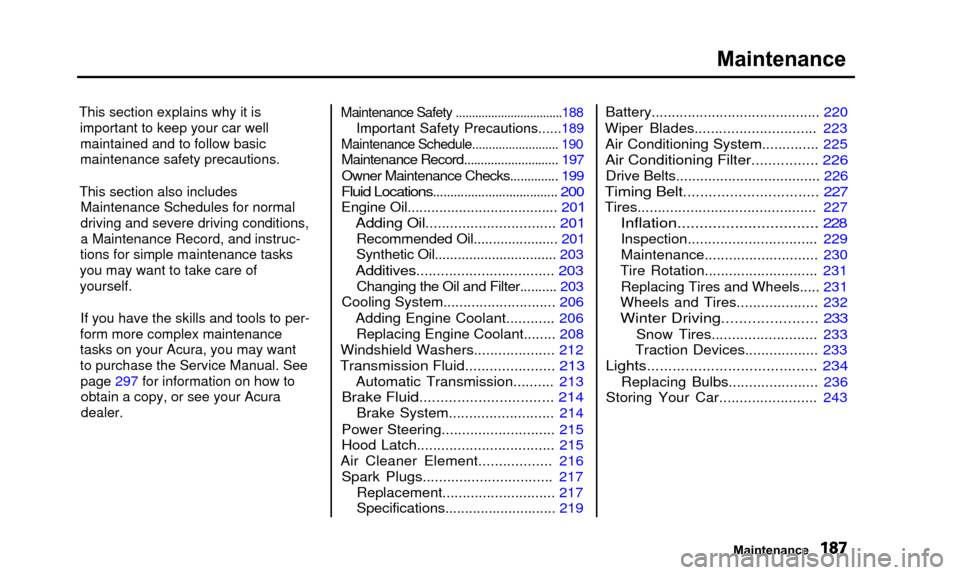
Maintenance
This section explains why it isimportant to keep your car wellmaintained and to follow basic
maintenance safety precautions.
This section also includes Maintenance Schedules for normal
driving and severe driving conditions,
a Maintenance Record, and instruc-
tions for simple maintenance tasks
you may want to take care of
yourself.
If you have the skills and tools to per-
form more complex maintenance
tasks on your Acura, you may want
to purchase the Service Manual. See page 297 for information on how toobtain a copy, or see your Acuradealer. Maintenance Safety .................................188
Important Safety Precautions......189
Maintenance Schedule
.......................... 190
Maintenance Record ............................ 197
Owner Maintenance Checks.............. 199
Fluid Locations.................................... 200
Engine Oil...................................... 201
Adding Oil................................ 201
Recommended Oil...................... 201
Synthetic Oil................................ 203
Additives.................................. 203
Changing the Oil and Filter.......... 203
Cooling System ............................ 206
Adding Engine Coolant............ 206 Replacing Engine Coolant........ 208
Windshield Washers .................... 212
Transmission Fluid...................... 213
Automatic Transmission.......... 213
Brake Fluid................................ 214
Brake System .......................... 214
Power Steering ............................ 215
Hood Latch.................................. 215
Air Cleaner Element .................. 216
Spark Plugs................................ 217
Replacement............................ 217
Specifications............................ 219Battery..........................................
220
Wiper Blades.............................. 223 Air Conditioning System.............. 225
Air Conditioning Filter................ 226
Drive Belts.................................... 226
Timing Belt................................ 227
Tires............................................ 227
Inflation................................ 228
Inspection................................ 229
Maintenance............................ 230
Tire Rotation............................ 231
Replacing Tires and Wheels..... 231
Wheels and Tires.................... 232
Winter Driving...................... 233
Snow Tires.......................... 233
Traction Devices.................. 233
Lights........................................ 234
Replacing Bulbs...................... 236
Storing Your Car........................ 243
Maintenance
Page 197 of 311
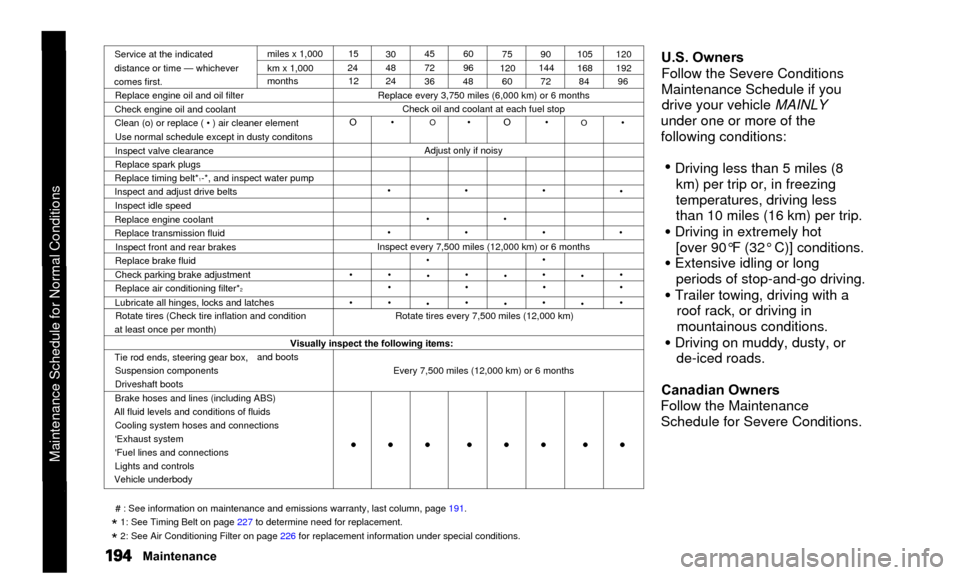
Service at the indicated
distance or time — whichever
comes first. miles x 1,000
km x 1,000
months
Replace engine oil and oil filter
Check engine oil and coolant
Clean (o) or replace ( • ) air cleaner element Use normal schedule except in dusty conditons
Inspect valve clearance
Replace spark plugs
Replace timing belt*
1-*, and inspect water pump
Inspect and adjust drive belts
Inspect idle speed
Replace engine coolant
Replace transmission fluid Inspect front and rear brakes
Replace brake fluid
Check parking brake adjustment
Replace air conditioning filter*
2Lubricate all hinges, locks and latches Rotate tires (Check tire inflation and condition
at least once per month) 15
24 12 30
48
24 45
72
3660
96
48 75
120 60 90
144
72 105
168
84 120
192
96
Replace every 3,750 miles (6,000 km) or 6 months Check oil and coolant at each fuel stop
O •
O • O •
Adjust only if noisy
•
•
•
•
•
•
•
•
O •
•
•
Inspect every 7,500 miles (12,000 km) or 6 months
•
• •
•
•
•
•
••
•
••
•
•
• •
•
•
••
•
•
Rotate tires every 7,500 miles (12,000 km)
Visually inspect the following items:
Tie rod ends, steering gear box, Suspension components
Driveshaft boots and boots
Brake hoses and lines (including ABS)
All fluid levels and conditions of fluids Cooling system hoses and connections
'Exhaust system
'Fuel lines and connections
Lights and controls
Vehicle underbody Every 7,500 miles (12,000 km) or 6 months
U.S. Owners
Follow the Severe Conditions
Maintenance Schedule if you
drive your vehicle MAINLY
under one or more of the
following conditions:
• Driving less than 5 miles (8 km) per trip or, in freezing
temperatures, driving less
than 10 miles (16 km) per trip.
• Driving in extremely hot[over 90°F (32° C)] conditions.
• Extensive idling or long periods of stop-and-go driving.
• Trailer towing, driving with a roof rack, or driving in
mountainous conditions.
• Driving on muddy, dusty, orde-iced roads.
Canadian Owners
Follow the Maintenance Schedule for Severe Conditions.
# : See information on maintenance and emissions warranty, last column, \
page 191.
* 1: See Timing Belt on page 227 to determine need for replacement.
* 2: See Air Conditioning Filter on page 226 for replacement information under special conditions.
Maintenance
Maintenance Schedule for Normal Conditions• • • • • • • \
•
Page 199 of 311

NOTE:• Check engine oil and coolant at each fuel stop.• Check and adjust valve clearance, cold engine, if noisy.# : See information on maintenance and emissions warranty, last
column, page 191.
* 1: See Timing Belt on page 227 to determine need for replacement.
* 2: See Air Conditioning Filter on page 226 for replacement
information under special conditions.
Maintenance
82,500 mi/132,000 km/5½ vrs
86,250 mi/138,000 km/-
90,000 mi/144,000 km/6 vrs
93,750 mi/150,000 km/-
97,500 mi/156,000 km/6½ yrs101,250 mi/162,000 km/-
105,000 mi/168,000 km/7 yrs
108,750 mi/174,000 km/-
112,500 mi/180,000 km/7½yrs 116,250 mi/186,000 km/-
120,000 mi/192,000 km/8 yrs Do items in A, B.
Do items in A.
Replace brake fluid. Do items in A, B, C, D. Do items in A.
Do items in A, B.
Do items in A.
Replace timing belt*1, and inspect water pump. Replace coolant. Check idle speed. Clean air cleaner element. Replace spark
plugs. Inspect valve clearance.
Do items in A, B, C.
Do items in A.
Do items in A, B.
Do items in A.
Replace timing belt*
1, inspect water pump.
Do items in A, B, C, D.
C Check parking brake adjustment.
Lubricate all hinges, locks and latches.• Inspect brake hoses and lines (including ABS).
Check all fluid levels, condition of fluids, and check for leaks.
Inspect cooling system hoses and connections.
#Inspect exhaust system.
•' #Inspect fuel lines and connections.
Check all lights.
Inspect the underbody. Replace air cleaner element.
• Inspect and adjust drive belts.
• Replace transmission fluid.
• Replace air conditioning filter*
2.
Maintenance Schedule for Normal Conditions (listed by distance/time)
Page 202 of 311
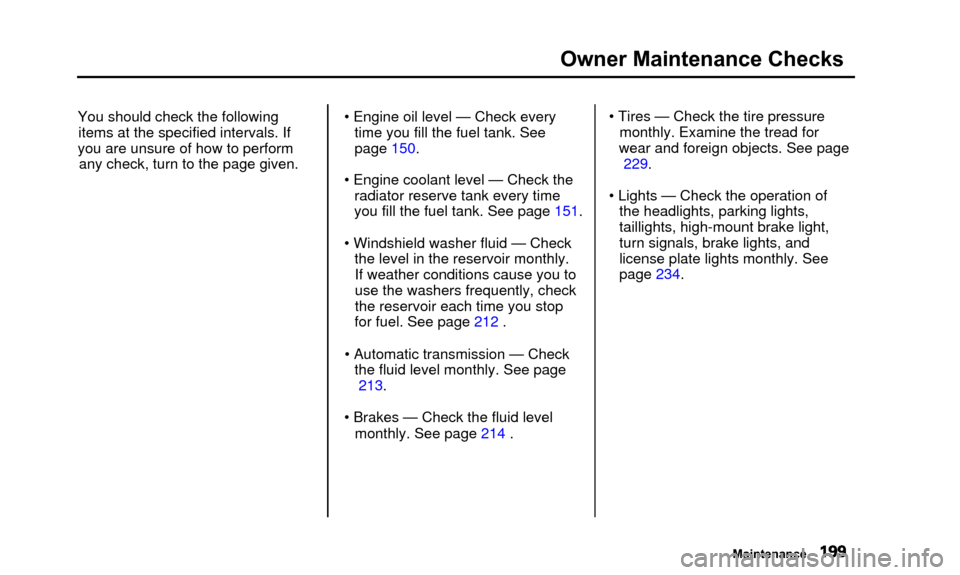
Owner Maintenance Checks
You should check the followingitems at the specified intervals. If
you are unsure of how to perform any check, turn to the page given. • Engine oil level — Check every
time you fill the fuel tank. See
page 150.
• Engine coolant level — Check the radiator reserve tank every time
you fill the fuel tank. See page 151.
• Windshield washer fluid — Check the level in the reservoir monthly.If weather conditions cause you to
use the washers frequently, check
the reservoir each time you stop
for fuel. See page 212 .
• Automatic transmission — Check the fluid level monthly. See page213.
• Brakes — Check the fluid level monthly. See page 214 . • Tires — Check the tire pressure
monthly. Examine the tread for
wear and foreign objects. See page
229.
• Lights — Check the operation of the headlights, parking lights,
taillights, high-mount brake light,
turn signals, brake lights, and
license plate lights monthly. See
page 234.
Maintenance
Page 208 of 311
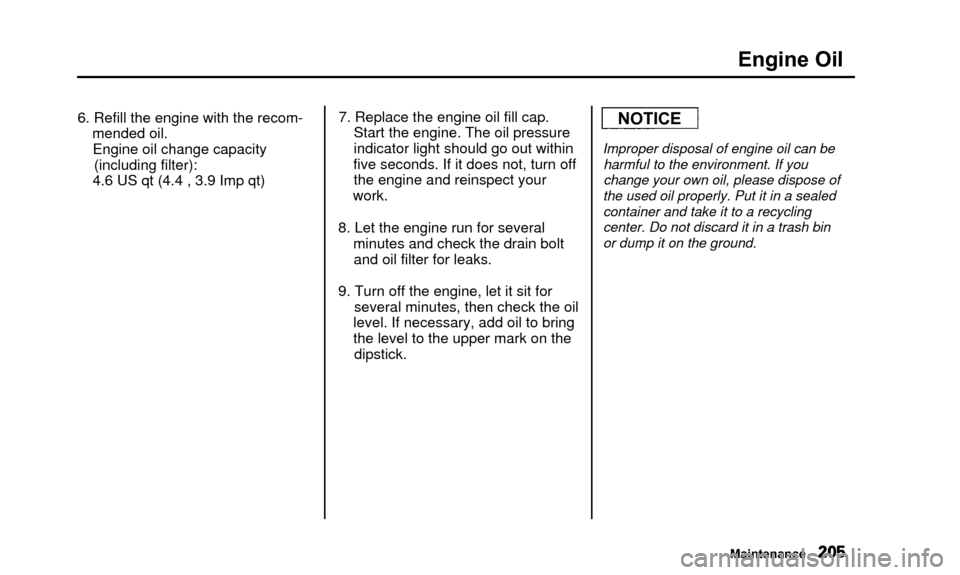
Engine Oil
6. Refill the engine with the recom-mended oil.Engine oil change capacity (including filter):
4.6 US qt (4.4 , 3.9 Imp qt) 7. Replace the engine oil fill cap.
Start the engine. The oil pressure
indicator light should go out within
five seconds. If it does not, turn off the engine and reinspect your
work.
8. Let the engine run for several minutes and check the drain boltand oil filter for leaks.
9. Turn off the engine, let it sit for several minutes, then check the oil
level. If necessary, add oil to bring
the level to the upper mark on the dipstick.
Improper disposal of engine oil can be
harmful to the environment. If you
change your own oil, please dispose of
the used oil properly. Put it in a sealed
container and take it to a recycling
center. Do not discard it in a trash bin
or dump it on the ground.
Maintenance
NOTICE